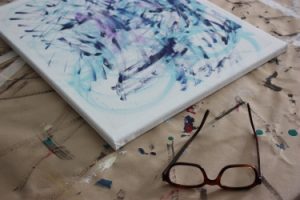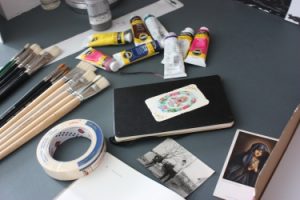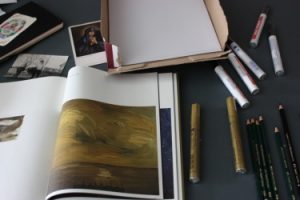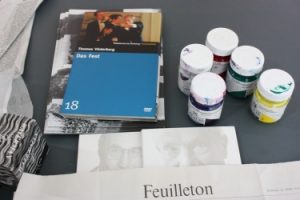In the midst of preparations for the opening of Up The Walls, I spoke to Carsten Fock, our artist-in-residence for the month of June. I was invited to look around his studio as he discussed his artistic method, in relation to his installation that can now be viewed as part of Up The Walls (which runs through to September 30th). Carsten Fock currently works and lives between Vienna and Berlin.
For his Up The Walls installation, Fock created the works in-house at our artist-in-residence studio. He likes to create artworks that initially look quite simple but that require further interpretation.

Fock reveals that defining himself as an artist hasn’t always come naturally to him. He stopped painting for a while after art school, trying drama instead and admits that painting does not come as habitually to him as drawing does, it is almost accidental, a sort of burden, this in turn loans its name to his catalogue “Backpack”. He laughs when he tells me that sometimes he finds it hard to proritise his art because he gets so caught up in reading books on German philosophy and especially post war German and American art.

The use of purple in his work is significant, there is a religious aspect omni-present in his installations. Fock regularly uses Christian imagery, this inclincation is most apparent in his past exhibitions, such as “The Devil.” (The September Gallery, Berlin, 2009). Fock’s own background is as intriguing as his installations, born into a Christian family in Soviet Germany, with Jewish roots on his Grandmother’s side, Fock escaped in 1988 into West Germany and went on to study art there.

In his installations Fock does not discriminate between the individual pieces, prefering to maintain them as part of the overall effect. He layers his drawings and paintings within the installation, this, he says, reflects the pace of life we live in now, we are over loaded with images on a daily basis.

Fock’s work reveals his preoccupation with simple, clean forms, he isn’t particularly interested in creating illustrative painting, for him, there must be a need, a reason behind the inclination to paint. He references German post-war art in his work, and is drawn to silhouettes, he uses sketches of German philosophers such as Heidegger, overlaid on his paintings and canvasses. His installation can be viewed in The Model until September 30th 2012.


Zwischen Berg und tiefen, tiefen Tal-
Heidegger, der deutsche Wald,
Wittgenstein und der Verlust der Moderne
From the mountain and the deep, deep valley-
Heidegger, the german forest,
Wittgenstein and the loss of modernity
Installation
Wallpainting, pigment and resin, mixed media on canvas and pastel on paper
2012, Sligo
Courtesy of the artist and gallery Jochem Hempel Leipzig / Berlin
